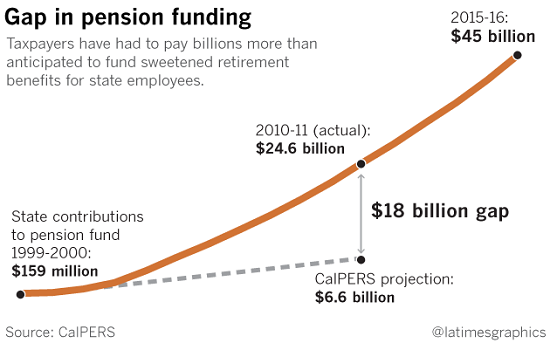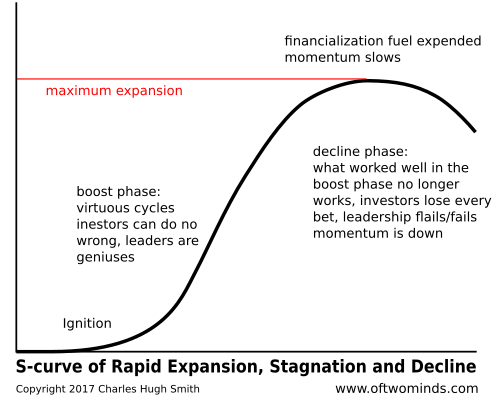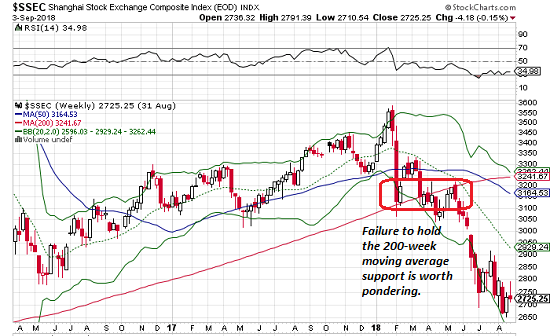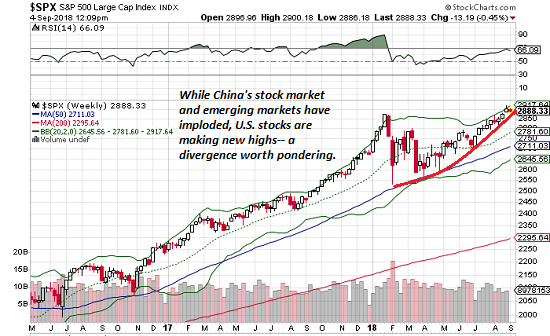
…click on the above link to read the rest of the article…
News and views on the coming collapse
Home » Posts tagged 'of two minds' (Page 16)
The way forward is to replace the entire system of reserve currencies with a transparent free-for-all of all kinds of currencies.
Over the years, I’ve endeavored to illuminate the arcane dynamics of global currencies by discussing Triffin’s Paradox, which explains the conflicting dual roles of national currencies that also act as global reserve currencies, i.e. currencies that other nations use for global payments, loans and foreign exchange reserves.
The four currencies that are considered global are the US dollar (USD), the euro, the Japanese yen and China’s RMB (yuan). The percentage of use in each of the three categories of demand for the reserve currencies–payments, loans and foreign exchange reserves–are displayed below.
Many observers don’t seem to grasp that demand for reserve currencies extend beyond payments. Many of those heralding the demise of the USD as a reserve currency note the rise of alternative payment platforms as evidence of the USD’s impending collapse.
But it’s not so simple. Currencies are also in demand because loans were denominated in that currency, so interest and principal payments must also be paid in that currency. There is also demand for the currency to be held as foreign exchange reserves–the equivalent of cash to settle trade imbalances and back the domestic currency.
Notice the minor role played by the yen and yuan, despite the size of the economies of Japan and China. There’s a reason for this that’s at the core of Triffin’s Paradox: any nation seeking to issue a reserve currency must export its currency in size by running large, permanent trade deficits (or an equivalent mechanism for exporting currency in size).
…click on the above link to read the rest of the article…
The defaults and currency crises in the periphery will then move into the core.
It’s funny how unintended consequences so rarely turn out to be good. The intended consequences of central banks’ unprecedented tsunami of stimulus (quantitative easing, super-low interest rates and easy credit / abundant liquidity) over the past decade were:
1. Save the banks by giving them credit-money at near-zero interest that they could loan out at higher rates. Savers were thrown under the bus by super-low rates (hope you like your $1 in interest on $1,000…) but hey, bankers contribute millions to politicos and savers don’t matter.
2. Bring demand forward by encouraging consumers to buy on credit now.Nothing like 0% financing to incentivize consumers to buy now rather than later. Since a mass-consumption economy depends on “growth,” consumers must be “nudged” to buy more now and do so with credit, since that sluices money to the banks.
3. Goose assets based on interest rates by lowering rates to near-zero. Bonds, stocks and real estate all respond positively to declining interest rates. Corporations that can borrow money very cheaply can buy back their shares, making insiders and owners wealthier. Housing valuations go up because buyers can afford larger mortgages as rates drop, and bonds go up in value with every notch down in yield.
This vast expansion of risk-assets valuations was intended to generate a wealth effectthat made households feel wealthier and thus more willing to binge-borrow and spend.
All those intended consequences came to pass: the global economy gorged on cheap credit, inflating asset bubbles from Shanghai to New York to Sydney to London. Credit growth exploded higher as everyone borrowed trillions: nation-states, local governments, corporations and households.
While much of the hot money flooded into assets, some trickled down to the real economy, enabling enough “growth” for everyone to declare victory.
…click on the above link to read the rest of the article…
In the present era of decadence, Universal Basic Income (UBI) is the modern equivalent of Bread and Circuses.
The dynamics of decadence are easy to understand: as affluence becomes the norm that is widely assumed to be permanent, shared purpose and sacrifice for the common good is replaced by self-absorbed decadence and an ethos of maximizing personal gain.
In his seminal essay The Fate of Empires, Sir John Glubb listed these core dynamics of imperial decline:
(a) A growing love of money as an end in itself.
(b) A lengthy period of wealth and ease, which makes people complacent. They lose their edge; they forget the traits (confidence, energy, hard work) that built their civilization.
(c) Selfishness and self-absorption.
(d) Loss of any sense of duty to the common good.
Glubb included the following in his list of the characteristics of decadence:
— An increase in frivolity, hedonism, materialism and the worship of unproductive celebrity.
— A loss of social cohesion.
— The willingness of an increasing number to live at the expense of a bloated bureaucratic state.
Glubb’s list may at first glance be largely psychological–self-aggrandizement and a focus on hedonistic pursuits–but the dynamics of decadence have economic, political and social ramifications.
First and foremost, the aristocratic financial and political elites secured their position at the expense of social mobility by erecting barriers that protect them from competition and accountability. In effect, they eliminated the risk posed by change by rigging the system to their benefit.
To fund their extravagant lifestyles, they took more of the earnings of those below them, widening the inequality between the aristocracy and commoners to extremes. Historian Peter Turchin reports that where the patricians of the Roman Republic had 10 or 20 times the wealth of an average Roman citizen, by the late Empire the elites possessed up to 200,000 times the wealth of the average commoner.
…click on the above link to read the rest of the article…

…click on the above link to read the rest of the article…
Rather than fight a system designed to thwart us, we need a model for our own lives that bypasses the perverse tides and obsoletes the impediments in our path.
Everyone wants to change their lives for the better (or preserve what’s positive), and this is relatively straightforward in a healthy system with positive incentives and a transparent, productive set of rules and feedbacks.
But what if the system is broken? How do we change our lives for the better in a dysfunctional system of unearned privilege and perverse incentives? Needless to say, it’s difficult, and this is why we see a rise in inward-directed solutions.
If we can’t change the external world we inhabit, then the “solution” is to nurture an inner tranquility. It’s no wonder that Taoism–perhaps the ultimate inner-directed philosophy–arose during the Warring States era in China, when social unrest and conflict were endemic.
But what about real-world changes such as improving our health, fitness, resilience, work/career satisfaction, income security and psychological well-being? When it comes to affecting real-world changes in a broken system, it often feels like we’re swimming against the tide: the system doesn’t make positive improvements easy, despite an abundance of lip service to individual goals such as losing weight, improving our career options, etc.
There are number of reasons for this; here are a few:
1. The economy, society and systems of governance are all changing in fundamental ways. I’ve written a lot about these forces– AI, robotics, globalization, financialization, the concentration of wealth and power at the top, etc. –and how we can respond positively, particularly in my books A Radically Beneficial World and Get a Job, Build a Real Career and Defy a Bewildering Economy.
…click on the above link to read the rest of the article…
It isn’t easy to add new subway lines or new highways, and so “solutions” don’t really exist.
If there’s one thing Americans can still agree on, it’s that America needs to spend more on infrastructure which is visibly falling apart in many places. This capital investment creates jobs and satisfies everyone’s ideological requirements: investment in public infrastructure helps enterprises, local governments and residents.
Unfortunately, it isn’t a simple as spending another trillion dollars. Spending money is the easy part; actually fixing what’s broken isn’t just a matter of spending more money.
The poster child for spending trillions on infrastructure and getting very little value is Japan, which has funneled much of its fiscal stimulus over the past 30 years into vast and largely needless infrastructure projects: bridges and roadways that are lightly used being just one example.
The reason for the this low-value-creation policy is the political power of the construction industry and the convoluted political structure which gives rural areas inordinate political power over public spending. As a result, enormously expensive and utterly needless highways and bridges litter lightly populated rural communities which have become dependent on construction jobs for what little remains of the local economy.
In other words, what’s broken in Japan remains broken. Spending more on infrastructure hasn’t fixed what’s dragging the nation into permanent stagnation.
If you live in any of America’s major urban centers (or happen to visit), you know that traffic congestion is now off the scale. From Portland to Las Vegas to Atlanta, traffic jams and crushing commutes are now the norm.
Soaring housing costs have pushed workers farther into the exurbs, lengthening commutes and choking highways constructed for a much smaller populace.
…click on the above link to read the rest of the article…
Want to understand the full scope of neofeudalism in America? Follow the money and the power and privilege it buys.
The repugnant reality of class privilege in America is captured by the phrasedate rape: the violence of forced, non-consensual sex is abhorrent rape when committed by commoner criminals, but implicitly excusable date rape when committed by a member of America’s privileged elite.
Compare the effectiveness of excuses offered by privileged elites (we were both drinking, I didn’t hear her say no, etc.) when offered in court by less privileged males on trial for rape. The privileged elite is acquitted or given a wrist-slap while the commoner gets 20 years in prison.
This implicit privilege to non-consensual sex was known as Droit du Seigneur(right of the lord) in feudal Europe. While scholars debate whether the right of lords to have their way with female subjects was institutionalized, it doesn’t take much imagination to see the lack of recourse unmarried female serfs had if summoned to the lord’s lair.
The “right” to non-consensual sex is simply one facet of class privilege in America. One need only examine the histories of Harvey Weinstein and Bill Clinton to see how Droit du Seigneur works in America: from the perverse perspective of the privileged, the female “owes” the “lord” sex as “payment” for his interest in her, or (even more offensively, if that’s possible) the female is “fortunate” to have attracted the violent sexual gratification of the “lord.”
While the standard presumption of sexual assault / date-rape is that it’s all about sex, the much more disturbing reality is that it’s a crime of violence.Force and violence are also privileges of the New Aristocracy, both the direct violence of sexual assault and indirect violence threatened or manifested by the innumerable thugs that surround the New Aristocracy.
…click on the above link to read the rest of the article…
The nation is failing as a direct consequence of these four catastrophic policies.
It’s admittedly a tough task to select the four most disastrous presidential policies of the past 60 years, given the great multitude to choose from. Here are my top choices and the reasons why I selected these from a wealth of policy disasters.
1. President Johnson’s expansion of the Vietnam War, which set the stage for President Nixon’s continuation of that disastrous war for an additional five years.
For those who missed the 30-minute lecture on the Vietnam War in history class, Johnson took a low-intensity guerrilla war in South Vietnam in which the U.S. was supporting a corrupt and venal South Vietnamese elite and expanded it into a full-blown war with over 500,000 troops on the ground and numerous other forces engaged in a vast regional conflict.
Johnson’s basic motivation was domestic politics: being a domestic political animal, Johnson was obsessed by the possibility that the Republicans could accuse the Democrats of being “soft on Communism” and win congressional seats in the next election if he declared victory and withdrew from Vietnam.
To insure this wouldn’t happen, Johnson relentlessly pursued a war in ways that guaranteed it couldn’t be won while killing and maiming millions of people, mostly civilians, and squandering the lives of U.S. servicemen and women.
Johnson did not follow the Constitutional requirement of declaring war with congressional approval. He opted to undermine the Constitution with an open-ended declaration of Imperial Presidential Powers (The Gulf of Tonkin Resolution) to wage unlimited war based on a “fake news” fictitious attack on U.S. ships in the Gulf of Tonkin.
…click on the above link to read the rest of the article…
Credit bubbles are not engines of sustainable employment, they are only engines of malinvestment and wealth destruction on a grand scale.
We all know the Status Quo’s response to the global financial meltdown of 2008 has been a travesty of a mockery of a sham–smoke and mirrors, flimsy facades of “recovery,” simulacrum “reforms,” serial bubble-blowing and politically expedient can-kicking, all based on borrowing and printing trillions of dollars, yen, euros and yuan, quatloos, etc.
So when will the travesty of a mockery of a sham finally come to an end? Probably around 2022-25, with a few global crises and “saves” along the way to break up the monotony of devolution. The foundation of this forecast is this chart I prepared back in 2008 (below).
This is of course only a selection of cycles; many more may be active but these four give us a flavor of the confluence of crises ahead.
Cycles are not laws of Nature, of course; they are only records of previous periods of growth/excess/depletion/collapse, not predictions per se. Nonetheless their repetition reflects the systemic dynamic of growth, crisis and collapse, and so the study of cycles is instructive even though we stipulate they are not predictive.
What is predictable is the way systems tend to follow an S-curve of rapid growth with then tops out in excess, stagnates in depletion and then devolves or implodes. We can see all sorts of things topping out and entering depletion/collapse: financialization, the Savior State, Chinese credit expansion, oil production, student loan debt and so on.

Since each mechanism that burns out or implodes tends to be replaced with some other mechanism, this creates the recurring cycle of expansion / excess / depletion / collapse.
I plotted four long-wave cycles in the first chart:

…click on the above link to read the rest of the article…
When the herd thunders off the cliff, most participants are trapped in the stampede..
One of the most perverse consequences of the central banks “saving the world” (i.e. saving banks and the super-wealthy) is the destruction of low-risk investments: we’re all speculators now, whether we know it or acknowledge it.
The problem is very few of us have the expertise and experience to be successful speculators, i.e. successfully manage treacherously high-risk markets. Here’s the choice facing money managers of pension funds and individuals alike: either invest in a safe low-risk asset such as Treasury bonds and lose money every year, as the yield doesn’t even match inflation, or accept the extraordinarily high risks of boom-bust bubble assets such as junk bonds, stocks, real estate, etc.
The core middle-class asset is the family home. Back in the pre-financialization era (pre-1982), buying a house and paying down the mortgage to build home equity was the equivalent of a savings account, with the added bonus of the potential for modest appreciation if you happened to buy in a desirable region.
In the late 1990s, the stable, boring market for mortgages was fully financialized and globalized, turning a relatively safe investment and debt market into a speculative commodity. We all know the results: with the explosion of easy access to unlimited credit via HELOCs (home equity lines of credit), liar loans (no-document mortgages), re-financing, etc., the hot credit-money pouring into housing inflated a stupendous bubble that subsequently popped, as all credit-asset bubbles eventually do, with devastating consequences for everyone who reckoned their success in a rising market was a permanent feature of the era and / or evidence of their financial genius.
…click on the above link to read the rest of the article…
America’s problem isn’t a lack of deficit spending/consumption. America’s problems are profoundly structural.
The nice thing about free to me money from any source is the recipients don’t have to change anything. Free money is the ultimate free-pass from consequence and adaptation: instead of having to make difficult trade-offs or suffer the consequences of profligacy, the recipients of free money are saved: they can continue on their merry way, ignoring the monumental dysfunction of their lifestyle.
This explains the appeal of Modern Monetary Theory (MMT), which holds that deficit spending is the “solution” to all our problems because governments can’t go broke–they can always emit whatever currency they need via printing or borrowing.
The problem with government deficit spending is it’s free money to the recipients: there are no feedback mechanisms to enforce any consequences for spending that’s wasteful, fraudulent or inefficient/ineffective.
Deficit spending simply enables the wasteful, corrupt, rewarding-insiders profiteering state-cartel kleptocracy to continue gorging on public spending.So what desperately needed efficiencies and improvements are imposed on the higher education cartel by handing the cartel another trillion dollars of public spending? None.
What desperately needed efficiencies and improvements are imposed on the healthcare cartel by handing the cartel trillions of dollars in publicly funded “Medicare for all”? None.
What desperately needed efficiencies and improvements are imposed on the national defense cartel by handing the cartel additional trillions of public spending? None.
What kind of sense does it make to encourage wasteful consumption on a finite planet with limited resources? The entire rationale of Modern Monetary Theory (MMT) is that the productive capacity of the economy isn’t being maxed out because we’re not consuming enough.
…click on the above link to read the rest of the article…
Neither small business nor the bottom 90% of households can afford this “best economy ever.”
After 10 years of unprecedented goosing, some of the real economy is finally overheating: costs are heating up, unemployment is at historic lows, small business optimism is high, and so on–all classic indicators that the top of this cycle is in.
Financial assets have been goosed to record highs in the everything bubble.Buy the dip has worked in stocks, bonds and real estate–what’s not to like?
Beneath the surface, the frantic goosing has planted seeds of financial crisis which have sprouted and are about to blossom with devastating effect. There are two related systems-level concepts which illuminate the coming crisis: the S-Curve and non-linear effects.
The S-Curve (illustrated below) is visible in both natural and human systems.The boost phase of rapid growth/adoption is followed by a linear phase of maturity in which growth/adoption slows as the dynamic has reached into the far corners of the audience / market: everybody already caught the cold, bought Apple stock, etc.
The linear stage of maturity is followed by a decline phase that’s non-linear.Linear means 1 unit of input yields 1 unit of output. Non-linear means 1 unit of input yields 100 unit of output. In the first case, moving 1 unit of snow clears a modest path. In the second case, moving 1 unit of snow unleashes an avalanche.
The previous two bubbles that topped/popped in 2000-01 and 2008-09 both exhibited non-linear dynamics that scared the bejabbers out of the central bank/state authorities accustomed to linear systems.
In a panic, former Fed chair Alan Greenspan pushed interest rates to historic lows to inflate another bubble, thus insuring the next bubble would manifest even greater non-linear devastation.
…click on the above link to read the rest of the article…
ponents.
A funny thing happens on the way to stabilizing things by doing more of what’s failed: the system becomes even more unstable, brittle and fragile.
A peculiar faith in pushing extremes to new heights has taken hold in official circles over the past decade: when past extremes push the system to the breaking point and everything starts unraveling, the trendy solution in official circles is to double-down, pushing even greater extremes. If this fails, then the solution is to double-down again. And so on.
So when uncreditworthy borrowers default on stupendous loans they were never qualified to receive, the solution is to extend even more stupendous sums of new credit so the borrower can roll over the old debt and make a few interest payments for appearance’s sake (also known as “saving face.”)
A funny thing happens on the way to stabilizing things by doing more of what’s failed: the system becomes even more unstable, brittle and fragile.
Central banks and states have latched onto a solution akin to a perpetual-motion machine: the solution to all problems is simple: print or borrow another trillion. If the problem persists, repeat the print/borrow another trillion until it goes away.
Consider China, a nation (like many others) dependent on a vast, never-ending expansion of credit. So what happens when defaults start piling up in the shadow banking system? The central bank/state authorities conjure up a couple trillion yuan (a.k.a. liquidity) so defaults go away: here, Mr. Bad-Risk-Default, is government-issued credit so you can pay off your defaulted private-sector loan. Everybody saves face, private losses have been transferred to the public sector/state, problem solved.
Small banks over-extended and technically insolvent? Solution: print or borrow another trillion and give the insolvent bank the dough. Problem solved!
…click on the above link to read the rest of the article…
If the world’s economies still need central bank life support to survive, they aren’t healthy–they’re barely clinging to life.
The “recovery”/Bull Market is in its 10th year, and yet central banks are still tiptoeing around as if the tiniest misstep will cause the whole shebang to shatter: what are they so afraid of? The cognitive dissonance / crazy-making is off the charts:
On the one hand, central banks are still pursuing unprecedented stimulus via historically low interest rates, liquidity and easing the creation of credit on a vast scale. Some central banks continue to buy assets such as stocks and bonds to directly prop up the “market.” (If assets don’t actually trade freely, is it even a market?)
On the other hand, we’re being told the global economy is in synchronized growth and this is the greatest economy ever in the U.S. and China.
Wait a minute: so the patient has been on life-support for 10 years and authorities are telling us the patient is now super-healthy? If the patient is so healthy, then why is he still on life support after 10 years of “recovery”? If the global economy is truly healthy, then central banks should end all their stimulus programs and let the market discover the price of credit, risk and assets.
If the economy is truly expanding organically, i.e. under its own power, then it doesn’t need the life-support of manipulated low interest rates, trillions of dollars in central bank asset purchases, trillions of dollars in backstopping, guarantees, credit swaps, etc.
If the economy were truly recovering, wouldn’t central banks have tapered their stimulus and intervention long ago? Instead, central bank stimulus skyrocketed to new highs in 2015-2017 as global markets took a slight wobble.
…click on the above link to read the rest of the article…


…click on the above link to read the rest of the article…